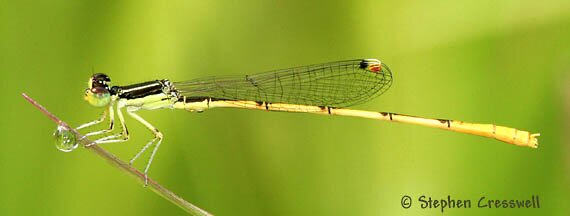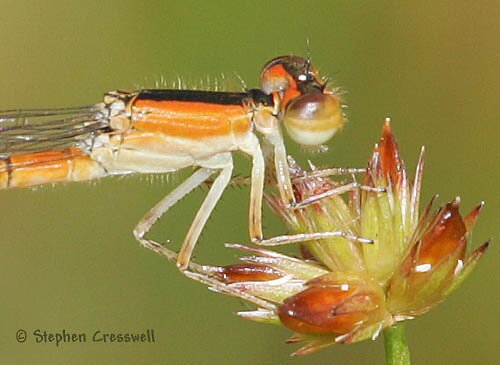

Family: Coenagrionidae
Length: 20-27 mm
It is easy to identify a male Citrine Forktail. It is the only damselfly in our region that has a completely yellow tip to the abdomen, with the final three segments all-yellow. One interesting oddity is that the Citrine Forktail has different colored stigmas, reddish on the front wing and black on the hind wing.
The female Citrine Forktail has orange coloration similar to that of other female Forktails, but the Citrine Forktail female is the only female damselfly in West Virginia with segments 1-5 and 9-10 mostly orange. As with other female Forktails, older individuals may turn a pruinose blue or gray as they age, making identification difficult.
The Citrine Forktail is the smallest damselfly in West Virginia, typically measuring about 9/10ths of an inch. Sometimes their coloration makes them easy to spot, but other times they blend in well with the light-colored grasses. They may be found at well-established ponds as well as at temporary pools. While missing from the northwestern states, the Citrine Forktail ranges across the Caribbean, Mexico, and Central and South America.
DNA studies of Ischnura species have revealed that while Ischnura posita and Ischnura verticalis are fairly closely related, Ischnura hastata is not so close (Chippindale, et al., 1999).

|
| Above: Male Citrine Forktails may be identified by the completely yellow coloration on the final three segments of the abdomen. The appearance of the tiny projections (cerci) at the tip of the abdomen is typical of this species, but these are not easily seen in the field. |

|
| Above: Other female Forktails, mature or immature, may be orange and black. How to tell the Citrine Forktail apart from the others? In West Virginia, only the Citrine Forktail female has segments 1-5 and 9-10 mostly orange. |

|
| Above: The broad black stripe seen above is the middorsal stripe. Most damselflies also have a lower stripe called a shoulder stripe. The young female Citrine Forktail, however, has no dark shoulder stripe (or at most a hairline thin one). Identifying older female Citrine Forktails is more of a challenge, as a brown shoulder stripe may develop, and bluish pruinosity begins to obscure the orange and black elsewhere. |


